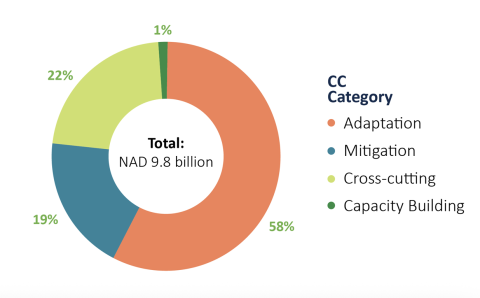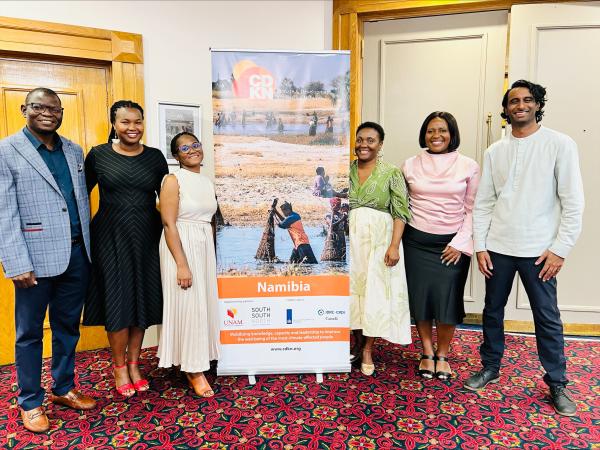Improving local access to climate finance: Lessons from the CDKN Namibia country programme
Improving local access to climate finance: Lessons from the CDKN Namibia country programme
Financing sustainable climate action in Namibia
Namibia ranks amongst one of the most climate vulnerable and low readiness to climate change countries in the Global South with climate impacts intensified by its reliance on rain-fed agriculture and limited livelihood opportunities. Recent years have brought prolonged droughts, devastating floods, and extreme temperatures to the region. These conditions disproportionately affect the poorest and most marginalised communities, who lack adequate safety nets against extreme weather events and climate-related diseases.
As a signatory to the Paris Agreement, Namibia has outlined its climate commitments through its Nationally Determined Contribution (NDC), however, implementing these actions requires substantial financial investment—an estimated USD 15 billion by 2030. Securing and unearthing adequate climate finance is therefore crucial for Namibia to successfully meet its climate goals and build resilience for its most vulnerable populations. However, tracking the flow of climate funding from global, national and local constituencies is not always a simple undertaking.

Namibia’s climate finance challenge: Bridging the gap to local communities
A key study conducted by Triple Capital revealed that between 2015 and 2020, Namibia mobilised a total of USD 32 million for climate adaptation through the Ministry of Environment, Forestry and Tourism (MEFT), the country’s National Designated Authority. However, less than 1% of this funding reached the local level. While adaptation investments dominated—comprising 58% of funding compared to 19% for mitigation—the share reaching local communities remained unclear. Only around 4% of projects during this period were locally owned.

To address this, CDKN Namibia recently held a workshop to identify existing finance flows, barriers to accessing finance, and opportunities for local climate adaptation funding. The Climate and Development Knowledge Network (CDKN) operates as a southern, demand-led global programme that advances gender-responsive, socially inclusive climate-resilient development across Africa, Latin America, and Asia.
Key limitations of the global climate finance landscape and recommendations for inclusive, local climate action
The global climate finance landscape is complex and constantly evolving. Most funding currently flows through multilateral channels, including mechanisms within and outside the United Nations Framework Convention on Climate Change (UNFCCC) financial network, as well as through various bilateral and regional initiatives. In response to this complexity, more countries are establishing national climate funds that can receive financing from multiple sources, helping to better align contributor interests with national priorities.
Despite these efforts, significant challenges persist in the global climate finance ecosystem:
-
Funding for climate adaptation and mitigation, particularly in the Global South, remains woefully insufficient to address the escalating climate crisis;
-
The fragmented distribution of climate finance from global to local levels creates barriers to locally-led action; and
-
In Namibia, nationally tracking and monitoring global climate finance flows continues to be difficult and inconsistent.
The CDKN workshop uncovered several key barriers and recommendations to devolving climate finance from national to local levels in Namibia, these include:
-
Institutional and governance challenges
Namibia could greatly benefit from a comprehensive national climate finance framework. Currently, limited coordination across and within different government levels hinders the development of a comprehensive mechanism to track domestic finance flows. Namibia’s Environmental Investment Fund (EIF) is currently the country’s sole Green Climate Fund (GCF) accredited entity, limited to USD 10 million in projects. Therefore, it’s important to strengthen public-private partnerships to encourage collaboration among the government, private sector, and communities. This will help promote internal financing solutions, enabling Namibia to explore ways to mobilise domestic resources to reduce its reliance on external donors. Increasing the number of GCF-accredited entities could also help. These actions would contribute to establishing robust mechanisms within the MEFT. Such mechanisms would help track local climate finance flows, in turn enhancing the transparency and accountability needed for effective resource management. Long-term success therefore requires policy and institutional support.
-
Capacity, skills and climate literacy gaps
Climate literacy among sub-national stakeholders in Namibia remains a significant challenge, particularly at constituency level, and institutional technical capacity at national level is insufficient for addressing this challenge. In response, the CDKN Namibia team, in partnership with the MEFT, and the Office of the Prime Minister (OPM), has been rolling out climate change adaptation capacity strengthening workshops to all 14 regions in the country since 2019. Increasing climate literacy will enhance access to climate finance for accelerated socially inclusive climate-resilient rural development, including training on grant proposal writing, succession planning and skills transfer. Building local expertise is therefore crucial for sustainable climate adaptation.
-
Classification and awareness barriers
Namibia’s high middle-income status limits access to adaptation financing, and donor requirements are often misaligned with local needs. Poor contextualisation of climate change terminology creates confusion between development and adaptation projects. For instance, although the majority of climate finance is allocated to the agricultural sector, agricultural funding frequently goes unreported as climate finance, and awareness of funding opportunities remains low at community levels. In response to this challenge CDKN Namibia recommends the following course of actions:
-
Bridging information gaps by developing toolkits and resources that help local entities access climate finance, building on NNF's Climate Finance Directory;
-
Facilitating stakeholder connections through forums that unite financiers and communities, aligning their needs and interests;
-
Shifting mindsets by highlighting existing climate finance opportunities and helping communities leverage these resources; and
-
Developing context-specific solutions by defining "locally-led adaptation" in the Namibian context will go a long way in creating inclusive environments for locally-led adaptation action.
-
Implementation Challenges
The high project failure rate at the local level was highlighted as a key concern, with limited accountability for outcomes and minimal investment in sustaining local capacity being the main contributing factors. Effective project implementation requires community involvement and ringfenced investment into the monitoring and evaluation of outcomes.
Considering these, the CDKN Namibia programme has been employing approaches such as Oxfam’s Vulnerability and Risk Assessment (VRA) tool to ensure community engagement in identifying local climate change risks and co-designing local climate-resilient development pathways. Learning from successful models like Community-Based Natural Resource Management (CBNRM) remains an opportunity for further exploration.

Recommendations for sustainable, accessible and inclusive climate finance to local communities in Namibia:
-
Strengthening institutional frameworks: Develop a National Climate Finance Framework to transparently map Namibia's climate finance landscape, identifying gaps and streamlining access.
-
Enhancing coordination: Broaden the national Climate Finance Working Group to formally include diverse non-governmental stakeholders, like the University of Namibia, fostering collaborative decision-making.
-
Strengthening local capacity: Simplify climate change communication for local understanding and empower local organizations to effectively access and manage domestic and international climate finance.
-
Enhancing accountability of local adaptation projects: Implement reimbursable grants with clear payback mechanisms or establish revolving funds to foster greater accountability and local ownership.
-
Addressing social dimensions: Integrate peacebuilding and conflict resolution programs within climate finance initiatives to mitigate potential community-level conflicts and ensure equitable benefits.
Systemically addressing these barriers will enable Namibia to improve the flow of climate finance to local communities, where adaptation efforts are most urgently needed. Focused engagement with key financiers in the Namibia climate finance space, both public and private, are planned and ongoing under the CDKN Namibia country programme, and will inform the co-design of targeted interventions with key stakeholders across national and sub-national levels. This will foster a more inclusive, effective climate finance ecosystem that truly empowers local communities to lead their own adaptation efforts.
For more information, please visit Namibia | CDKN
